|
|
8 MON - BLUE BELT
|
|
WARNING: THIS PAGE COULD BE UPDATED AT ANY TIME, SO YOU SHOULD REVIEW IT OFTEN
Here you will find all of the
information that you will need to prepare you for your grading. This information includes
your theory and your practical test. I hope this information will help you in giving
you a better understanding about Kyokushin Karate and also gives you a better
understanding of your requirements and at the same time helps you to study and
prepare for it. Let Sensei know two weeks in advance if you want to test in
other date than the regular testing date.
MEANING OF THE BELTS
Below you will find a possible interpretation of the symbolism of the belt colors. I hope this will give a further understanding the sense in which the Obi (belts) colors mean. Belts colors are not only to reflect growth in technique, but also in character.
The Blue Belt (Fluidity - Adaptability)
Many people reach
this rank. This represents the water that comprises the oceans, air and
atmosphere. It has a power within it self. The student is introduced to
Karate, as a child is introduce to life. The basic movement and concepts
introduced are like the initial steps taken by a young child as they begin to
walk. This first steps provide the frame work that will allow him/her to run
tomorrow, and feel confident enough to find his/her own way. During this
period the students develop coordination and balance. At the same time the
students begin to work on their bodies, specially on their strength and flexibility.
Also, at this level the students should develop a better control of their mind and
body which would help to overcome the hard training.
![]()
WHAT YOU SHOULD KNOW FOR YOUR
KYOKUSHIN WRITING TEST
8 MON - BLUE BELT
Important Note: To do your Writing Test you must bring a pencil, eraser, and a sharpener.
Below are some vocabulary you should be able to know in order to do your grading.
|
VOCABULARY (8 MON) |
|
|
Name |
Meaning |
| Shita | Lower |
| Shita Tsuki | Lower punch |
| Jun Tsuki | Off shoulders punch |
| Seiken Jun Tsuki Jodan | High off the shoulder punch |
| Seiken Jun Tsuki Chudan | Middle off the shoulder punch |
| Seiken Jun Tsuki Gedan | Lower off the shoulder punch |
| Tate | Vertical |
| Seiken Tate Tsuki Jodan | High Vertical Punch |
| Seiken Tate Tsuki Chudan | Middle Vertical Punch |
| Seiken Tate Tsuki Gedan | Lower Vertical Punch |
| Tate Kudasae | Stand up (Stand up Vertical) |
| Ago | Chin |
| Seiken Ago Uchi | Punch to the Chin |
| Morote | Double / Both hands |
| Seiken Morote Chudan Uchi Uke | Two hands block from the inside |
| Chudan Uchi Uke | Middle inside block |
| Gedan Barai | Lower block |
| Seiken Chudan Uchi Uke/Gedan Barai | Middle block and Lower block at the same time |
| Mae Geri Jodan Chusoku | High front kick, using the ball of the foot |
| Ago Mae Geri | Front kick to the Chin-Jaw, using the ball of the foot |
| Kokutso Dachi | Back Stance |
| Kiba Dachi | Horse straddle stance |
| Sanbon | Three steps |
| Kumite | Sparring |
| Sanbon Kumite | Three steps sparring |
| Idogeiko | Moving basics |
| Mawatte | Turn around |
| Naore | Return to starting position |
| Kyu Ju Do | 90 degrees |
| Yon Ju Go Do | 45 degrees |
YOU SHOULD KNOW AND HAVE A DETAIL UNDERSTANDING OF:
|
Who was Sosai Masutatsu Oyama (Biography) | |
|
History of Kyokushin | |
|
Taikyoku Sono San Kata | |
|
The meaning of Blue Belt |
![]()
Kyokushin Kata has its origins in :
TAIKYOKU ICHI, NI, SAN (OMOTE):
| Taikyoku Sono Ichi | |
| Taikyoku Sono Ni (Movie, 1 Camera Movie, 3 Camera) | |
| Taikyoku Sono San |
The Taikyoku Katas, were developed by Sensei Gichin Funakoshi (1868 - 1958) the father of modern Karate.
![]()
Below you will find all what you need to know for your grading. It was designed to supply the students with information about their requirements for their grades. If you have any question regarding the requirements consult your teacher. The grading requirements in our school contain the following:
8th MON - ( BLUE BELT )
NOTE: Please keep in mind that the students must pay the testing fees ($20) 2 weeks before they give the writing test. the testing fees cover the cost of the Belt and certificate.
| Time in Classes : 20 Months ( One class a week -
90 minutes class ) : 10 Months ( Two classes a week - 90 minutes class ) : 7 Months ( Three classes a week - 90 minutes class ) |
Theory (including all the above):
| Students must know the previous syllabuses | |
| Meaning of : -
Kyokushin Calligraphy |
| 30 Hands Push Ups | |
| 10 Knuckle Push Ups | |
| 30 Deep Knee Bends With Front Kick | |
| 30 Sit Ups | |
| 100 Jumping Jacks or 4 Min. Jump Rope (2 set of 2 Min) |
| Kokutsu Dachi (Back Stance) | |
| Kiba Dachi (Horse Stance) |
2) Tsuki Waza: (Punches - Strikes):
| Seiken Jun Tsuki Jodan (High off the shoulder punch) | |
| Seiken Jun Tsuki Chudan (Middle off the shoulder punch) | |
| Seiken Jun Tsuki Gedan (Lower off the shoulder punch) | |
| Seiken Tate Tsuki Jodan (High vertical punch) | |
| Seiken Tate Tsuki Chudan (Middle vertical punch) | |
| Seiken Tate Tsuki Gedan (Lower vertical punch) |
| Seiken Morote Chudan Uchi Uke (Double inside block) | |
| Seiken Chudan Uchi Uke / Seiken Gedan Barai (Middle inside block/Downward
block) |
| Mae Geri Jodan Chusoku (High front kick, using the ball of the foot) | |
| Ago Mae Geri (Front kick to the Chin-Jaw, using the ball of the foot) |
5) Idogeiko: (Basic Moving)
| Seiken Jun Tsuki Jodan/Chudan/Gedan (Going forward in Kiba Dachi) | |
| Seiken Tate Tsuki Jodan/Chudan/Gedan (Going forward in Zenkutsu Dachi) | |
| Seiken Morote Chudan Uchi Uke (Going forward in Zenkutsu Dachi) | |
| Seiken Chudan Uchi Uke / Seiken Gedan Barai (Going forward in Zenkutsu Dachi) | |
| Mae Geri Jodan Chusoku (Going forward in Zenkutsu Dachi) | |
| Ago Mae Geri (Going forward in Zenkutsu Dachi) |
6) Katas (Forms):
| Taikyoku Sono San (Movie, 1 Camera Movie, 3 Camera) |
太極 Taikyoku:
Taikyoku is literally translated as “grand ultimate”, “first cause” from the characters Tai 太, meaning big, and Kyoku 極, meaning extreme, conclusion or end. In Chinese, the kanji characters are pronounced Tai Chi (or Taiji). The word Taikyoku can also mean overview or the whole point – seeing the whole rather than focusing on the individual parts, and keeping an open mind or beginner’s mind. The beginner’s mind is what is strived for during training and in life. The beginner’s mind does not hold prejudice and does not cling to a narrow view. The beginner’s mind is open to endless possibilities. These Katas was created by Gichin Funakoshi (1868-1958) the father of modern Karate.
Written Step-By-Step Instructions for Kyokushin Karate Kata Taikyoku Sono San:
N= North W= West E= East S= South
N
W E
S
| Ready position (yoi dachi, facing South) | |
| Turn left 90 degrees, back stance (kokutso dachi), middle inside-to-outside block (chudan uchi uke) (toward East on this case, depending on how you are positioning) | |
| Step forward into front stance (zenkutso dachi), middle punch (seiken chudan tsuki) | |
| Turn right 180 degrees, back stance (kokutso dachi), middle inside-to-outside block (seiken chudan uchi uke) (toward West on this case, depending on how you are positioning) | |
| Step forward into front stance (zenkutso dachi), middle punch (seiken chudan tsuki) | |
| Turn left 90 degrees, front stance (zenkutso dachi) with low block (seiken gedan barai) (Change direction to the centerline, toward South on this case, depending on how you are positioning) | |
| Step forward into front stance (zenkutso dachi), middle punch (seiken chudan tsuki) | |
| Step forward into front stance (zenkutso dachi), middle punch (seiken chudan tsuki) | |
| Step forward into front stance (zenkutso dachi), middle punch (seiken chudan tsuki), yell KIAI | |
| Turn left 90 degrees, back stance (kokutso dachi), middle inside-to-outside block (chudan uchi uke) (toward West on this case, depending on how you are positioning) | |
| Step forward into front stance (zenkutso dachi), middle punch (seiken chudan tsuki) | |
| Turn right 180 degrees, back stance (kokutso dachi), middle inside-to-outside block (seiken chudan uchi uke) (toward East on this case, depending on how you are positioning) | |
| Step forward into front stance (zenkutso dachi), middle punch (seiken chudan tsuki) | |
| Turn left 90 degrees, front stance (zenkutso dachi), low block (seiken gedan barai) (Change direction to the centerline, toward North on this case, depending on how you are positioning) | |
| Step forward into front stance (zenkutso dachi), middle punch (seiken chudan tsuki) | |
| Step forward into front stance (zenkutso dachi), middle punch (seiken chudan tsuki) | |
| Step forward into front stance (zenkutso dachi), middle punch (seiken chudan tsuki), yell KIAI | |
| Turn left 90 degrees, back stance (kokutso dachi), middle inside-to-outside block (chudan uchi uke) (toward East on this case, depending on how you are positioning) | |
| Step forward into front stance (zenkutso dachi), middle punch (seiken chudan tsuki) | |
| Turn right 180 degrees, back stance (kokutso dachi), middle inside-to-outside block (seiken chudan uchi uke) (toward West on this case, depending on how you are positioning) | |
| Step forward into front stance (zenkutso dachi), middle punch (seiken chudan tsuki) | |
| Return to ready position (yoi dachi, facing South) |
7) Goshin Jitsu: (Self
Defense)
| Sanbon Kumite (Three-step
sparring)
: Basic punches & Basic blocking (Jodan
Uchi Uke, Chudan Uke, Gedan Barai and Soto Uke) use basic techniques to counter attack. Use appropriate interval or distance (ma-ai)
and also proper use of the Kime (focus). Sanbon Kumite #5 Attacker: Seiken Jodan Oi Tsuki-migi Defender: Seiken Jodan Gyaku Uke-migi & Seiken Chudan Oi Tsuki-hidari) Sanbon Kumite #6 Attacker: Seiken Chudan Oi Tsuki-migi Defender: Seiken Chudan Uchi Gyaku Uke-migi & Seiken Chudan Oi Tsuki-hidari ) Sanbon Kumite #7 Attacker: Seiken Gedan Oi Tsuki-migi Defender: Seiken Gedan Gyaku Uke-migi & Seiken Jodan Oi Tsuki-hidari Sanbon Kumite #8 Attacker: Seiken Chudan Oi Tsuki-migi Defender: Seiken Soto Gyaku Uke-migi & Seiken Chudan Oi Tsuki-hidari | |
| Ippon Kumite :
Basic punches and blocks (Jodan, Chudan, Gedan). Use basic counterattacking. | |
| Basic Release Techniques : Use Jodan Uke, Gedan Barai, Chudan Uchi Uke, and Soto Uke to release from wrist grabs. Use Basic counterattacking. | |
| Be able to recognize and avoid
dangerous places and dangerous People | |
| Gyakute (Grappling, Wrestling, Joint locking): Not required at this level. |
8) Renraku (Sparring Combinations):
| Using basic techniques ( hands techniques, striking and blocking ) |
9) Kumite (Sparring):
| Minimum of 3 Sparring of 2 minutes. |
The students should be able to execute the techniques using any of the
stances. Also the students would be tested on any techniques from previous belt.
WARNING: THIS PAGE COULD BE UPDATED AT ANY TIME, SO YOU SHOULD REVIEW IT OFTEN
![]()
STANCES AND WEIGHT
DISTRIBUTIONS (DACHI)
| KOKUTSU DACHI FROM YOI DACHI | ||
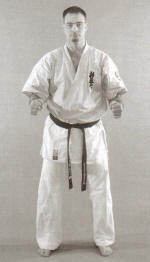 |
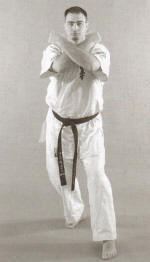 |
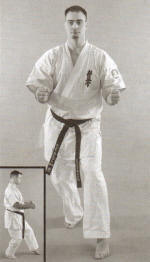 |
|
From Yoi Dachi step forward with your left leg. The distance from your front foot to your back foot should be approximately 3 steps, (the length of your foot is one step). The width of the stance should not be more than 5 cm. Your front foot is pointing straight head and the heel is about 5 cm off the floor. Your back foot is an angle of 45°. In Kokutsu Dachi your back leg takes most of the punishment. 70% of your weight is on your back leg and 30% is on your front leg. |
||
|
KOKUTSU DACHI IDO-GEIKO |
|
|
|
|
|
KOKUTSU DACHI
MAWATTE (TURNING AROUND IN KOKUTSU DACHI - BACK STANCE) |
|||
|
|
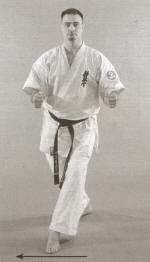 |
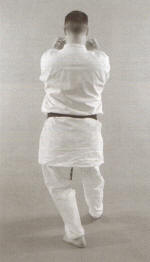 |
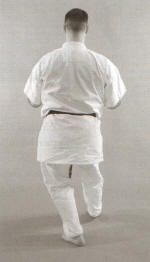 |
|
To perform the turn, move your front leg approximately half a shoulder width in length in a straight line. |
Cross your hands in front of you and pivot on the balls of your feet and turn 180° |
to complete the movement uncross your hands and bring them down. |
|
|
KOKUTSU DACHI NAORE ( Learning how to get back to the original position - Naore ) |
||
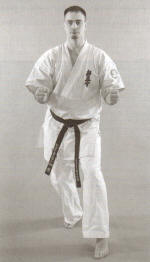 |
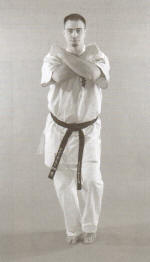 |
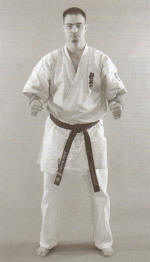 |
|
Move your front leg, in this case your left, towards your back leg until your feet are touching, at the same time move your hands across your chest and move the left foot out into Fudo Dachi. |
||
|
KIBA DACHI 90° ( Learning how to get back to the original position - Naore ) |
|||
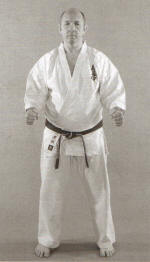 |
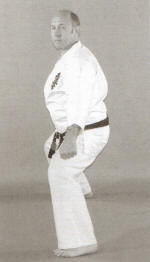 |
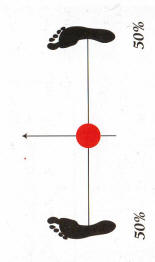 |
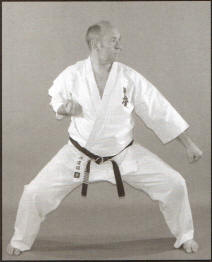 |
|
From Yoi Dachi step back with your right leg while blocking Gedan Barai. So that on completion of the step your feet are parallel. The stance is approximately two shoulder widths wide and your weight distributed equally on both feet. Bend your legs, push your knees out and keep your back straight. |
Kiba
Dachi |
SIDE VIEW |
|
|
KIBA DACHI IDO-GEIKO KIBA DACHI 90° ( Learning how to step in Kiba Dachi when Kicking) |
|||
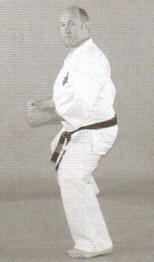 |
 |
 |
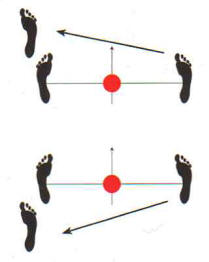 |
|
while stepping in Kiba Dachi and Kicking you have to cross your feet. On the first step your right foot crosses in front of the left and on the second it crosses behind the left. The final step is the same as the first. After Mawatte the steps are reversed, start by crossing your left foot behind your right. |
|
||
|
KIBA DACHI MAWATTE ( Learning how to turn around in Kiba Dachi) |
||
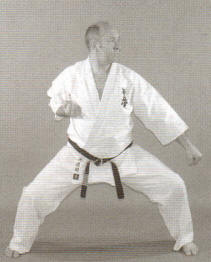 |
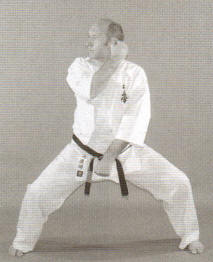 |
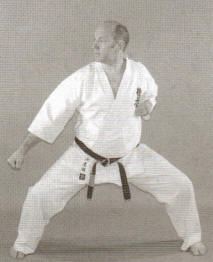 |
|
Turn your head 180° at the same time block Gedan Barai. Do not move your feet. |
||
|
KIBA DACHI NAORE ( Learning how to return to your initial stance from Kiba Dachi) |
||
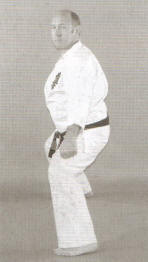 |
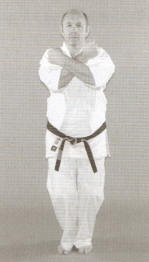 |
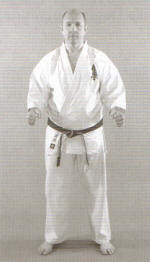 |
|
Move your back leg, in this case your right, towards your front leg until your feet are touching, at the same time move your hands across your chest and move your right foot out into Fudo Dachi. |
||
![]()
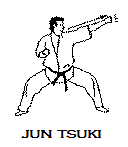 |
 |
| JODAN JUN TSUKI | JODAN TATE TSUKI |
![]()
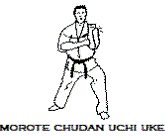 |
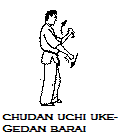 |
| SEIKEN MOROTE CHUDAN UCHI UKE | SEIKEN CHUDAN UCHI UKE/GEDAN BARAI |
![]()
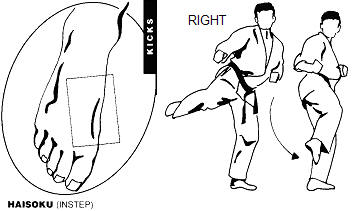 |
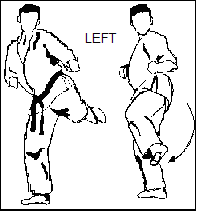 |
| GEDAN MAWASHI GERI HAISOKU | GEDAN MAWASHI GERI CHUSOKU |
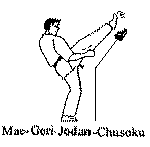 |
||
| Ago Mae Geri | Mae Geri Jodan Chusoku |
![]()
For more information contact your teacher, sensei Angel Carrasco at 663-8102 or e-mail him at: angel@kyokushincanada.com
GO TO THE MAIN PAGE OF WINNIPEG KYOKUSHIN KARATE - DOJO ENTHEOS